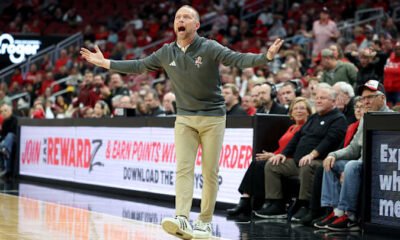Blog
Amazing New Information Regarding Derek Carr’s Injury That Caused His Retirement
Introduction
The NFL world was stunned on May 10, 2025, when New Orleans Saints quarterback Derek Carr announced his retirement after 11 seasons, citing an intractable shoulder injury that left him unable to perform at the level he demanded of himself . Until this announcement, Carr had shown no public indication that his marching towards the 2025 season would end so abruptly. However, in the days following his declaration, a series of insightful reports have surfaced, shedding light on the “mysterious” nature of his injury, the agonizing decision-making process he underwent, and the implications of his departure on both his personal finances and the Saints’ quarterback room .
Early Signs of Trouble
Carr’s physical struggles trace back to December 8, 2024, when he sustained a left-hand injury and concussion during a game against the New York Giants at MetLife Stadium . According to team sources, this contest marked his last full-contact appearance before the lingering shoulder issues began to dominate his offseason preparations . While Concussions and hand ailments are not uncommon in the NFL, Carr’s shoulder complaint proved far more insidious: he could not progress beyond a modest throwing volume without experiencing pain, effectively sidelining him during critical months of offseason development .
Discovery and Medical Diagnosis
It was not until late March 2025, as Carr ramped up his passing workload in preparation for the upcoming campaign, that the full severity of his condition became evident . In a detailed recount, NFL Media insider Mike Garafolo revealed that Carr began feeling sharp pain during throws of just 20 to 25 yards—a far cry from the long-range passing that had become his trademark . Subsequent medical scans performed by the Saints’ medical staff uncovered two devastating findings: a labral tear in Carr’s right shoulder and significant degenerative changes to his rotator cuff . These injuries compromised the structural integrity of his throwing shoulder, making even routine quarterback motions precarious.
Treatment Options and Performance Projections
Upon confirming the diagnoses, Carr and the Saints explored non-surgical avenues, including targeted injections and rehabilitative therapy, aiming to restore function without forcing him under the knife . However, team physicians estimated that these conservative measures would at best restore Carr to roughly 75% of his pre-injury capability—insufficient for the demands of NFL competition . The only path to full recovery (as defined by returning to 100% strength and range of motion) involved arthroscopic surgery, which carried a projected four-to-six-month rehabilitation timeline . Such a recovery window would have caused Carr to miss the bulk, if not the entirety, of the 2025 season, effectively ending his on-field contributions without any assurance of regaining his previous performance levels .
The Financial and Contractual Ramifications
Derek Carr’s retirement did not simply mark the end of an athletic career; it also carried significant financial consequences. Under the terms of his four-year, $150 million contract signed with the Saints in February 2023, Carr had $30 million fully guaranteed for the 2025 season in base salary and roster bonuses . By choosing to retire rather than remain on injured reserve, Carr effectively forfeited that $30 million guarantee . In exchange, however, he retained his $10 million signing bonus, as the parties reached an “amicable deal” that waived any recoupment provisions on the bonus proration . This arrangement allowed Carr and the Saints to part ways respectfully, while alleviating some of the team’s cap concerns for the upcoming seasons .
The Decision-Making Journey
Throughout April and early May, Carr underwent extensive consultations—not only with orthopedic specialists but also with his family and the Saints’ coaching staff . In his retirement statement, he referenced a period of prayer and reflection alongside his wife, Heather, indicating that personal considerations weighed heavily in his choice . Saints head coach Kellen Moore praised Carr’s communication and character, emphasizing that the quarterback’s departure was handled with transparency and mutual respect between player and organization . Ultimately, Carr concluded that walking away was in the best interests of his long-term health and overall well-being—a decisive act emblematic of a player prioritizing life beyond the playing field .
Impact on the New Orleans Saints’ Quarterback Room
With Carr’s retirement official, the Saints’ quarterback depth chart has been upended overnight. Having invested a second-round draft pick in Louisville’s Tyler Shough, New Orleans is now positioned to hand him the keys to the offense, pending his performance in training camp . Shough will now compete alongside Spencer Rattler and Jake Haener, both of whom have seen limited regular-season action to date . Despite the suddenness of Carr’s exit, the Saints appear bullish on a youth-driven approach, hoping to cultivate stability after rotating through eight different starters—eight, not counting Carr—since Drew Brees’s retirement at the end of the 2020 season .
Salary Cap and Roster Implications
Carr’s decision to forgo his 2025 salary frees up crucial cap space for the Saints’ front office, which had been facing a crowded financial ledger . His departure is projected to clear upwards of $16 million in 2026 cap charges while leaving minimal burden on the 2025 books, thanks to the retention of his signing bonus prorations . This newfound flexibility could pave the way for New Orleans to pursue upgrades in free agency or to extend key contributors remaining under contract, such as emerging star Alvin Kamara and cornerstone defensive pieces like Cameron Jordan .
Wider NFL Ripple Effects
Beyond New Orleans, Carr’s retirement has thrown the quarterback market into unexpected flux. An unanticipated vacancy in the NFC South has reignited discussion around veteran passer Aaron Rodgers, whose availability this offseason has already driven conflicting rumors among contenders like the Pittsburgh Steelers and the Saints themselves . With an additional $30 million in cap space courtesy of Carr’s retirement, the door may be ajar for Rodgers to consider a New Orleans swan song—should he choose to return in 2025 . Meanwhile, the Steelers remain prominent among suitors, but the financial calculus has unquestionably shifted since Carr vacated his roster spot .
Legacy and Conclusion
Over an 11-season span split between the Oakland/Las Vegas Raiders and the Saints, Derek Carr amassed 41,245 passing yards, 257 touchdowns, and 112 interceptions, earning four Pro Bowl nods and leaving behind a legacy of statistical consistency and professionalism . While his tenure in New Orleans lasted only two injury-marred campaigns, his impact on and off the field resonated with teammates, coaches, and fans alike . Ultimately, the revelation of his shoulder’s degenerative state underscores the physical toll exacted by the quarterback position—and highlights Carr’s willingness to prioritize his family and future over further gridiron glory.
Though his retirement marks the end of a remarkable NFL journey, the “amazing new information” surrounding his injury delivers a deeper appreciation for the resilience and integrity Derek Carr displayed throughout his career. As the Saints pivot towards a new era under Tyler Shough, the league bids farewell to one of its most durable and respected signal-callers—one whose departure was as calculated as his career-long approach to the game.
-

 Blog4 months ago
Blog4 months agoPat Kelsey sends a strong three-word fiery message to the Louisville basketball’s team after their Cardinals 14th win…
-

 Blog7 months ago
Blog7 months agoNetflix releases “The Underdog,” a much-anticipated documentary about Drew Brees. slated for publication on the 25th
-

 Blog4 months ago
Blog4 months agoMikaela Shiffrin responds to cross-country skier Jessie Diggins’ letter following her failure to secure a solitary podium finish at the FIS Nordic Worlds
-

 Blog2 months ago
Blog2 months agoBehind the Turns: Netflix’s Upcoming Documentary on Mikaela Shiffrin’s Fights, Fears, and Love
-

 Blog4 months ago
Blog4 months agoWomen’s Slalom Run 1 at the FIS Alpine Skiing World Cup: Are
-

 Blog4 months ago
Blog4 months agoLegacy Tour Led Zeppelin has officially confirmed their 2026 reunion tour, which will be their first extensive live performances since 2007. The “Led Zeppelin Legacy Tour 2026” will begin on June 10, 2026, at Los Angeles’ SoFi Stadium.
-

 Blog6 months ago
Blog6 months agoFederica Brignone: “I’m fine, but my return to skiing is far off.”
-

 Blog6 months ago
Blog6 months agoAlice Cooper: From Fragile Boy to Shock Rock Icon—Netflix Unmasks the Nightmare
